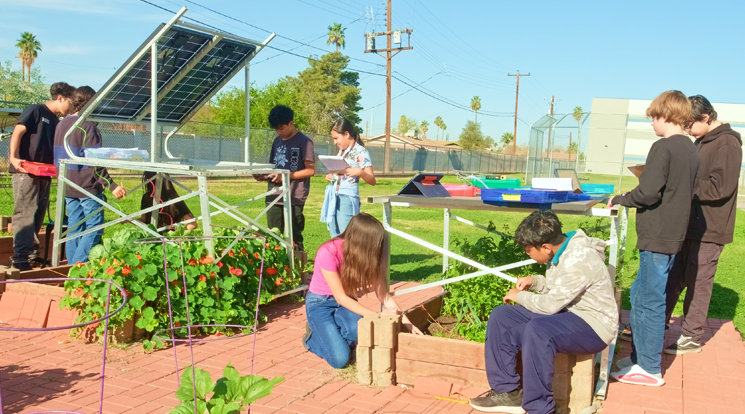Activating K–12 student learning through science

What if solar panels didn’t just generate electricity — but also helped grow your lunch? That’s the idea behind agrivoltaics, a science-based approach to farming that was the inspiration for a three-year initiative that encouraged K–12 students and educators to develop solutions in collaboration with their local communities.
Led by faculty with Arizona State University’s Mary Lou Fulton College for Teaching and Learning Innovation, the initiative — Sonoran Desert Photovoltaic Laboratory Citizen Science Network — connected ASU and University of Arizona engineering and education faculty with K–12 educators and students to design the STEM-based projects.
Their mission: examine how agrivoltaics, which involves combining agriculture with solar energy production, can improve access to healthy food and renewable power in communities across Arizona, where solar resources are abundant. Funding for the initiative came from the National Science Foundation.
“We’re creating a school-based citizen science network where students, teachers and researchers collaborate on real-world energy solutions,” said Michelle Jordan, an associate professor at MLFC. “The benefits are many. Students strengthen their STEM skills, connect with their local communities and see that their work matters beyond the classroom.”
Making science accessible
Jordan and Steven Zuiker, also a professor with MLFC, were the project leads, partnering with Christiana Honsberg, a professor in the Ira A. Fulton Schools of Engineering's School of Electrical, Computer and Energy Engineering.
The project reflects the impact of the MLFC’s Learning Futures Collaboratives, an initiative that connects academic research to community-based challenges. In this case, participating faculty represented two collaboratives: Imagination and Futures Thinking and Education for Planetary Futures. In addition, MLFC graduate research assistants Rebekah Jongewaard, Carlos Meza-Torrez and Emmanuel Adeloju worked closely with the MLFC faculty, along with engineering graduate student mentors.
Central to the project are solar-powered school gardens, one shaded by solar panels and the other exposed to full sunlight. Students maintained the twin garden beds while working with scientists and engineers to track variables like soil moisture, air temperature and plant growth. Throughout the project, students collected and analyzed data, presenting their findings at annual events, and sharpening their STEM skills.
To date, the program has reached more than 1,000 students across 28 schools around the Sonoran Desert.
“Typically you would think that science is only for professors or scientists in big companies, but it’s actually taught me so much more — that me, as an eighth grader, can do so much more,” said Sofia Blanco, a student at one of the participating schools. “I can help the world become a better place with just a little work.”
Supporting teacher professional learning
In addition to hands-on research, 30 K–12 STEM teachers participated in a series of six-week summer professional development sessions over the past three years. Teachers helped pilot and refine classroom activities, including a series of interactive games designed to illustrate the impact of historical decisions and explore local responses to water scarcity, food insecurity and rising energy demands.
The project also provided a testbed for action-oriented teaching methods that link science learning to real community needs, which is an approach shown to increase student engagement by emphasizing relevance and agency.
“These students get so excited about coming to school every day,” said Janet Ankrum, a teacher with Catalina Ventura School. “It’s shown an improvement in attendance as well as enthusiasm and motivation about our curriculum.”
Continuing the project
Throughout the year, students, teachers, mentors and partner organizations shared their work through virtual meetings, classroom visits, online conferences and in-person events. Even as the project completed its final year, the work is continuing through collaborations such as one with Growing Green.
A team of ASU undergraduate mentors was also recently awarded a grant from the 2025 Mesa Youth Climate Action Fund, made possible by Bloomberg Philanthropies. Their new project, Plants, Panels, and People: Growing Mesa’s Climate Action Capacity through Agrivoltaics, will expand the program to three additional schools next year.
Learn more and get involved
- Visit the SPV Lab project website to explore the student projects and find out more about how to join this network.
- Support the project’s efforts to sustain and scale its current impact through funding and partnerships. Contact: [email protected]